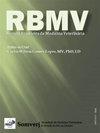Transovarial transmission and finding of Trypanosoma rhipicephalis in the hemolymph of Rhipicephalus sanguineus sensu latoa
Q4 Veterinary
引用次数: 3
Abstract
Trypanosoma rhipicephalis Marotta et al. (2018) is a species isolated from Rhipicephalus microplus ticks collected from native bovine Seropedica, in the state of Rio de Janeiro. This study aimed to investigate the interaction of the tick Rhipicephalus sanguineus s. l. with T. rhipicephalis by in vitro artificial feeding. Eight females of R. sanguineus s. l. partially fed on rabbits. Tick infection was performed by an artificial feeding system using plastic tips for 12 hours. Canine blood used for feeding the ticks test group was previously infected with T. rhipicephalis 108/mL. The hemolymph smear test was performed in all females after experimental infection. The daily posture was collected and organized in pools of each female per posture day. The eggs were divided into three groups, the first group for eggs PCR, the second for hatching and larval PCR, and the third group of eggs for isolation in cell culture. The evaluation of the presence of DNA in the macerated eggs of experimentally infected ticks showed two positive PCR samples. The evaluation of the presence of DNA in experimentally infected females showed all samples tested positive. For the hemolymph test, tick number 7 presented epimastigote developmental forms and amastigotes of T. rhipicephalis. Experimental infection by artificial feeding proved to be a suitable tool to study the interaction of T. rhipicephalis in R. sanguineus s. l. ticks. The results show the transovarial transmission of T. rhipicephalis by R. sanguineus s. l., as well as the interaction of the protozoan in the organism of this tick species.红头锥虫的经卵巢传播和血淋巴中发现
马罗塔(Marotta)等人(2018)是从巴西巴西里约热内卢州本地牛血清中采集的微型鼻头锥虫蜱中分离出来的一个物种。本研究旨在通过体外人工饲养的方法研究血头蜱与蜱头绦虫的相互作用。8只雌性血鼠部分以家兔为食。采用塑料针尖人工喂养系统进行蜱虫感染12小时。试验组用于喂养蜱虫的犬血既往感染根头绦虫108/mL。所有女性感染后均行血淋巴涂片检查。收集和整理每个女性每个姿势日的日常姿势。卵分为三组,第一组卵PCR,第二组卵孵化和幼虫PCR,第三组卵细胞培养分离。对实验感染蜱虫的浸渍卵中DNA的存在进行了评价,结果显示两个PCR样品呈阳性。对实验感染的女性DNA存在的评估显示,所有样本均呈阳性。血淋巴试验中,7号蜱表现为鼻头绦虫的附睾发育形式和无尾绦虫发育形式。人工饲养实验感染是研究血蜱与鼻头绦虫相互作用的较好方法。结果表明,弓形头绦虫可经血蜱经卵巢传播,并可在弓形头绦虫体内传播。
本文章由计算机程序翻译,如有差异,请以英文原文为准。
求助全文
约1分钟内获得全文
求助全文
来源期刊
CiteScore
0.80
自引率
0.00%
发文量
34
审稿时长
>12 weeks
期刊介绍:
The Brazilian Journal of Veterinary Medicine was launched in 1979 as the official scientific periodical of the Sociedade de Medicina Veterinária do Estado do Rio de Janeiro (SOMVERJ). It is recognized by the Sociedade Brasileira de Medicina Veterinária (SBMV) and the Conselho Regional de Medicina Veterinária do Estado do Rio de Janeiro (CRMV-RJ).

 求助内容:
求助内容: 应助结果提醒方式:
应助结果提醒方式:


